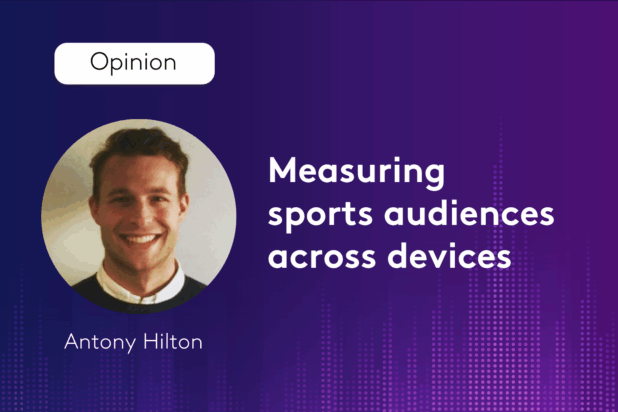As fans watch sport across devices, on the go, and in both private and public spaces, measurement must evolve to keep pace. Antony Hilton examines what meaningful innovation in sports audience measurement really looks like.

Sport has always had the power to bring audiences together in real time, across borders and generations. The way people watch sport, however, has changed in quite radical ways over the last two decades. From the traditional stadium and pub TVs, to smartphones and social feeds, sports viewing — like video more generally — is now a fragmented, ‘multidirectional’ phenomenon.
Linear channels remain hugely important, of course, particularly as sport continues to offer a unique social and live experience – but they no longer hold a monopoly on reach. The new reality is that fans, given the choice of how and when to engage, now dip in and out of coverage across platforms and contexts — and many of those viewing moments go unrecorded by traditional measurement tools.
This is a challenge for broadcasters and a critical visibility gap for rights holders, sponsors and advertisers looking to understand how sport is actually consumed, and where the commercial value truly lies.
That issue will come into focus this summer when DAZN broadcasts the FIFA Club World Cup live and free-to-air in a landmark global agreement. All 63 matches will stream across its digital platforms, with further distribution deals potentially extending reach via local TV networks. It’s being framed as the most accessible Club World Cup in history.
Sports rights are in flux. As we note in our latest Media Trends and Predictions, the biggest leagues still command premium prices, but many mid-tier competitions have hit a ceiling. In response, rights holders are turning to direct-to-consumer (DTC) models that offer greater control over distribution and fan data. That’s a rational move, but it creates new complexity. The viewing experience becomes more fragmented and the pathway to discovery less obvious. Fans find themselves navigating a maze of apps and logins just to follow their team. As a result, for brands or broadcasters trying to calculate reach, the view becomes clouded.
In short, traditional metrics no longer suffice. If sport is now watched across devices, on the move, in households and public spaces alike, then measurement must adapt to match. Consequently, cross-platform tracking — one that includes out-of-home and co-viewing — is now of high commercial interest.
That’s where initiatives like Kantar IBOPE Media’s Sports Audience Measurement (SAM) offer a glimpse of the future. Football is one of the largest media and entertainment platforms in Brazil, with millions of viewers and, as a result, significant investment from broadcasters in acquiring rights, as well as from advertisers desiring to showcase their brands. In Brazil, SAM has begun unifying viewership reporting across free-to-air TV, pay channels and streaming platforms on TV and CTV. That means the Campeonato Brasileiro and Copa do Brasil — the country’s two biggest domestic football competitions — can now be tracked in a more comprehensive way regardless of how or where a fan chooses to watch.
TV remains the primary screen for in-home sports viewing, as long-form matches are best suited for shared, high-quality viewing experiences — a behavior that is less common on mobile devices.
Beyond counting views, the enhanced system reflects the reality of how sport is consumed today, capturing co-viewing in households and benchmarking performance across screens. This approach testifies to the power of panels, remaining a critical asset, providing a representative and trusted view of in-home viewing, and serving as a key tool for calibrating big data and understanding audience behaviors in a highly fragmented media landscape. Crucially, it reflects the total audience in real time, helping rights holders and sponsors understand true reach, not just isolated platform performance.
This is very important. If sports viewing becomes too fractured, or if the measurement tools don’t adapt , there’s a real risk that competitions lose salience with the broader public. This could affect ticket sales, streaming subscriptions, sponsorship revenue and long-term brand equity and investment in sport.
Consider a scenario where a sponsor backs a tournament believing it will deliver 20 million eyeballs, based on linear-only estimates. But in reality, half that audience watched on a streaming platform, or in a gym, pub or airport, entirely unmeasured. The value exchange breaks down. That’s a risk to the sport’s commercial sustainability.
What matters now is moving beyond the limitations of platform-by-platform metrics. If sport is to retain its place at the heart of global culture — and continue to command investment from brands, broadcasters and fans — then measurement must reflect how viewing actually happens. It must be inclusive of all screens, all contexts, and all modes of engagement.
Complementary tools, such as Cross-Platform View™ further enrich this picture by helping to track overall platform usage — offering additional insights into broader trends in video consumption.
We already have the tools. The next step is adoption and mindset change. From counting viewers to understanding fans and from tracking platforms, to measuring experiences. If sport wants to thrive in this new media landscape, it needs to be seen and measured in full.
Antony Hilton is Kantar Media’s Senior Manager – Sports Intelligence